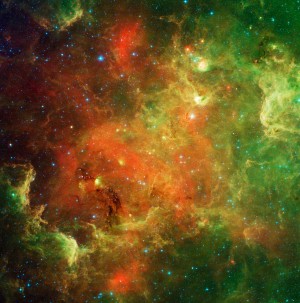Posts Tagged ‘first-quarter moon’
Sky Tonight—April 11, Moon passes by Gemini stars

Courtesy of EarthSky A Clear Voice for Science Visit EarthSky at www.EarthSky.org Tonight, the moon shines near Castor and Pollux, the brightest stars in the constellation Gemini the Twins. As seen mid-northern latitudes, the moon and the Gemini stars shine fairly high in the south to southwest sky at nightfall, and all three luminaries set in the west after midnight. As viewed from middle latitudes in the southern hemisphere, the moon, Castor and Pollux sit low in the northern sky at ... Full Story
Sky Tonight—March 13, Moon shines in front of Winter

Courtesy of EarthSky A Clear Voice for Science Visit EarthSky at www.EarthSky.org As seen tonight from all over the world, the moon passes right in front of the great big loop of stars known to northern hemisphere residents as the Winter Circle or the Winter Hexagon. This huge star formation makes even the constellation Orion the Hunter look small. Orion sits in the southwest (lower right) corner of the Winter Circle. The Winter Circle is an asterism – a group of stars that is NOT a ... Full Story
Sky Tonight—March 12, Moon between Capella and

Courtesy of EarthSky A Clear Voice for Science Visit EarthSky at www.EarthSky.org The first quarter moon will be shining between two brilliant stars tonight. Capella, the brightest star in the constellation Auriga, will be beaming north of the moon, while Betelgeuse, the star marking the right shoulder in the constellation Orion, will be shining south of the moon. From mid-northern latitudes in Europe and Asia, you will see the moon farther west (right), and closer to the star Aldebaran, than ... Full Story
Sky Tonight—February 11, Waxing gibbous moon near

Courtesy of EarthSky A Clear Voice for Science Visit EarthSky at www.EarthSky.org The waxing gibbous moon shines close to the Pleiades star cluster tonight. This cluster is also called the Seven Sisters. Because of the moonlit glare, you might need binoculars to see the dipper-shaped Pleiades cluster. As seen from North America, the Pleiades sit to the west (right) of tonight’s moon. As seen from mid-northern latitudes in Europe and Asia, the Pleiades sit to the moon’s east (or left). ... Full Story
Sky Tonight—January 12, Moon and stars of Aries

Courtesy of EarthSky A Clear Voice for Science Visit EarthSky at www.EarthSky.org Practiced stargazers sometimes use three stars of the constellation Aries the Ram to find an elusive galaxy – M74 – also known as the Phantom galaxy. As seen from the world this evening, the first quarter moon shines in front of the constellation Pisces the Fishes, not far at the Aries/Pisces border. The three stars mentioned above are to the moon’s upper left tonight. They depict the head of Aries the Ram. ... Full Story
EarthSky Tonight—September 14, Moon in forgotten

Courtesy of EarthSky A Clear Voice for Science www.EarthSky.org This evening, the moon shines above the constellation Scorpius and in front of Ophiuchus – the “overlooked” constellation of the Zodiac. Once upon a time, the border between Scorpius and Ophiuchus was not a particularly well-defined section of sky, until the International Astronomers Union officially drew in the constellation borders in the 1930’s. Although you will not see Ophiuchus on the horoscope page in the ... Full Story
Earthsky Tonight—June 18: A half-moon Joins Saturn

Courtesy of EarthSky A Clear Voice for Science www.EarthSky.org Tonight, you have another planet-packed evening in store, with a couple of brilliant beacons to point the way. Dazzling Venus is visible in the west as evening falls, and the first-quarter moon shines in the southwest as seen from the northern hemisphere. The brightest “star” near the half-lit moon is Saturn. Thanks to its majestic system of rings, it has become an icon of “outer space” and staple of science-fiction ... Full Story








